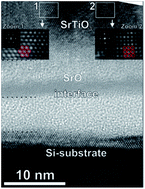Pulsed laser deposition of SrTiO3 on a H-terminated Si substrate
Abstract
Interfacing

* Corresponding authors
a Faculty of Science & Technology, MESA+ Institute for Nanotechnology, University of Twente, 7500 AE Enschede, The Netherlands
b
Advanced Materials Department, Jožef Stefan Institute, Jamova 39, 1000 Ljubljana, Slovenia
E-mail:
matjaz.spreitzer@ijs.si
c Electron Microscopy for Materials Research, University of Antwerp, Groenenborgerlaan 171, 2020 Antwerp, Belgium
Interfacing

 Please wait while we load your content...
Something went wrong. Try again?
Please wait while we load your content...
Something went wrong. Try again?
M. Spreitzer, R. Egoavil, J. Verbeeck, D. H. A. Blank and G. Rijnders, J. Mater. Chem. C, 2013, 1, 5216 DOI: 10.1039/C3TC30913D
To request permission to reproduce material from this article, please go to the Copyright Clearance Center request page.
If you are an author contributing to an RSC publication, you do not need to request permission provided correct acknowledgement is given.
If you are the author of this article, you do not need to request permission to reproduce figures and diagrams provided correct acknowledgement is given. If you want to reproduce the whole article in a third-party publication (excluding your thesis/dissertation for which permission is not required) please go to the Copyright Clearance Center request page.
Read more about how to correctly acknowledge RSC content.
 Fetching data from CrossRef.
Fetching data from CrossRef.
This may take some time to load.
Loading related content
